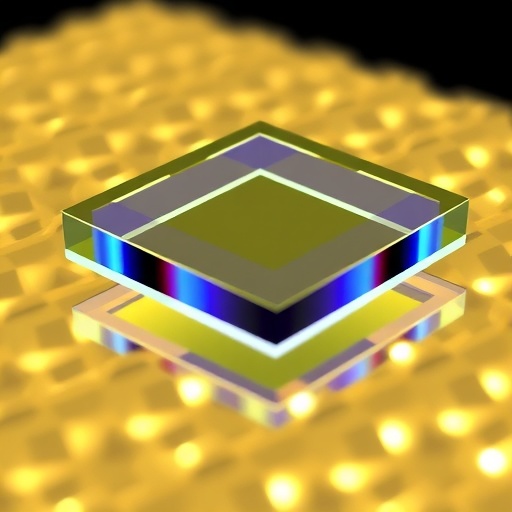A groundbreaking advancement in the realm of perovskite solar cell technology has emerged from the collaborative efforts of Professors Pengwei Li, Yanlin Song, and Yiqiang Zhang’s research team. Their pioneering work delves into the intricate interface engineering of quasi-two-dimensional (2D) alternating-cation-interlayer (ACI) perovskites, utilizing a molecular bridge based on dicyandiamide (DCD). Published in the esteemed journal Nano-Micro Letters, this study unlocks a dual-functional strategy that addresses long-standing challenges obstructing the trajectory toward efficient and stable perovskite photovoltaics.
At the core of this innovation is the molecular intricacy of dicyandiamide, a molecule endowed with guanidine and cyano functional groups, which drive synergistic effects at the buried interfaces within the perovskite architecture. The research reveals that the guanidine moiety preferentially binds with undercoordinated lead ions (Pb²⁺) and passivates vacancy defects inherent at the interface between perovskite layers. Concurrently, the cyano groups engage in coordination with titanium ions (Ti⁴⁺) in the electron transport layer (ETL), specifically titanium dioxide (TiO₂), alleviating electronic traps caused by oxygen vacancies. This molecular bridging facilitates not only defect passivation but also the robust coupling between the perovskite active layer and the ETL, enhancing charge transfer efficacy.
The implications of this intricate interface modification are profound. Experimentally, the DCD-mediated quasi-2D ACI perovskite solar cells demonstrate a remarkable leap in power conversion efficiency (PCE), reaching 21.54%, a significant jump from the 19.05% efficiency observed in unmodified control devices. This boost arises from the combined impact of reduced nonradiative recombination losses and an optimized phase distribution within the perovskite film. The suppression of low-n phases—known for their trap-mediated recombination—and the promotion of vertically aligned high-n phases facilitate uniform charge-carrier transport pathways, mitigating energetic disorder and interface recombination.
The research team’s comprehensive spectroscopy and theoretical investigations provide a mechanistic understanding that underpins these performance enhancements. X-ray photoelectron spectroscopy (XPS) and Fourier-transform infrared spectroscopy (FTIR) data confirm strong interactions between DCD molecules and both Pb and Ti centers, manifesting a decrease in surface defects. Notably, oxygen vacancy concentrations in TiO₂ are significantly diminished from 48% to 33%, a quantifiable indicator of improved interface quality. Complementary transient absorption (TA) and photoluminescence (PL) analyses further elucidate a homogeneous n-value phase distribution, effectively minimizing energy transfer losses that frequently curtail device efficiency.
Delving deeper into the molecular science, density functional theory (DFT) calculations reveal robust cyano-Ti coordination bonds that underpin the suppressed formation of interfacial traps, bolstered by guanidine-driven vacancy passivation at Pb sites. This dual-binding paradigm simultaneously stabilizes the buried interface and optimizes the ETL contact, an engineering feat that harmonizes the microstructural and electronic landscapes crucial for high-performance solar cells. The outcome is a more resilient perovskite-ETL interface that supports enduring device operation under practical stresses.
The optimized devices showcase outstanding photovoltaic parameters, including an open-circuit voltage (V_OC) of 1.172 V, a short-circuit current density (J_SC) of 23.08 mA/cm², and a fill factor (FF) approaching 79.6%. These metrics are symptomatic of efficient charge extraction and suppressed recombination pathways, conclusions supported by electrical impedance spectroscopy which finds recombination resistance elevated to an impressive 20.68 kΩ. The pronounced decrease in trap density, by over a factor of three, corroborates the enhanced charge carrier dynamics facilitated by the molecular bridging interface.
Beyond efficiency, the DCD-functionalized ACI perovskite solar cells demonstrate formidable operational stability—a critical criterion for commercial viability. The devices sustain 94% of their initial efficiency after prolonged exposure to thermal and environmental stress for 1200 hours, a substantial improvement over the 84% retention recorded in unmodified counterparts. Moreover, the modified cells endure continuous illumination stress for 400 hours without appreciable performance degradation, signaling robust photostability facilitated by the engineered interface.
This molecular bridge strategy achieves a long-sought decoupling of the conventional efficiency–stability trade-off that has historically hindered the advancement of 2D perovskite photovoltaics. By orchestrating the interplay between interface passivation and phase regulation, the approach yields films with reduced defect densities and uniform electronic landscapes, capable of sustained high performance. This methodology represents a paradigm shift, providing a scalable, chemically driven blueprint for next-generation perovskite solar cell fabrication.
Beyond the immediate scope of photovoltaic technology, this versatile interface engineering strategy holds potential applicability across a spectrum of perovskite-based optoelectronic devices, including light-emitting diodes (LEDs) and photodetectors. The molecular design principles exemplified here could be harnessed to tailor interfaces and phase behavior in diverse device architectures, thereby expanding the functional utility of perovskite materials in future photonic applications.
The study’s implications resonate across materials science, device physics, and chemical engineering disciplines, highlighting the power of targeted molecular modifications to optimize complex functional interfaces. This convergence of atomic-level chemical bonding insights and device-level performance improvements underscores the importance of interdisciplinary research for overcoming challenges in emergent energy conversion technologies.
In summary, the innovative work led by Professors Li, Song, and Zhang reveals how the precise incorporation of dicyandiamide molecules at critical perovskite interfaces fundamentally redefines the capabilities of quasi-2D ACI perovskite solar cells. Their molecular bridge strategy delivers record-setting efficiencies coupled with exceptional device stability, charting a promising pathway toward commercially viable and durable perovskite photovoltaics for the sustainable energy landscape of the future.
Article Title: Dicyandiamide-Driven Tailoring of the n-Value Distribution and Interface Dynamics for High-Performance ACI 2D Perovskite Solar Cells
News Publication Date: 23-Jun-2025
Web References: http://dx.doi.org/10.1007/s40820-025-01817-x
Image Credits: Ge Chen, Yunlong Gan, Shiheng Wang, Xueru Liu, Jing Yang, Sihui Peng, Yingjie Zhao, Pengwei Li, Asliddin Komilov, Yanlin Song, Yiqiang Zhang
Keywords: 2D Perovskite, Interface Engineering, Dicyandiamide, Solar Cells, Quasi-2D ACI Perovskites, Defect Passivation, Electron Transport Layer, Phase Regulation, Molecular Bridge, Photovoltaic Stability, Charge Carrier Dynamics
Tags: advanced materials for renewable energycharge transfer in solar cellsdefect passivation in perovskitesdicyandiamide interface engineeringenhancing solar cell efficiencyinterface modifications in photovoltaicsmolecular bridge in solar technologyperovskite architecture improvementsquasi-2D perovskite solar cellsstability in perovskite photovoltaicssynergistic effects in materials sciencetitanium dioxide electron transport layer






